For centuries around the globe, the humble dog has been considered man's best friend for many varying reasons. History has etched the dog from a companion to a workmate across many genres.
With the increasing popularity of off-grid living or purchasing a small dairy farm and living off the land, a common question that keeps popping up is "what are the best dog breeds for managing livestock."
When it comes to livestock guardians and herding/working dogs, there are many different breeds bred explicitly for particular climates and certain breeds of livestock. So let's take a deeper look
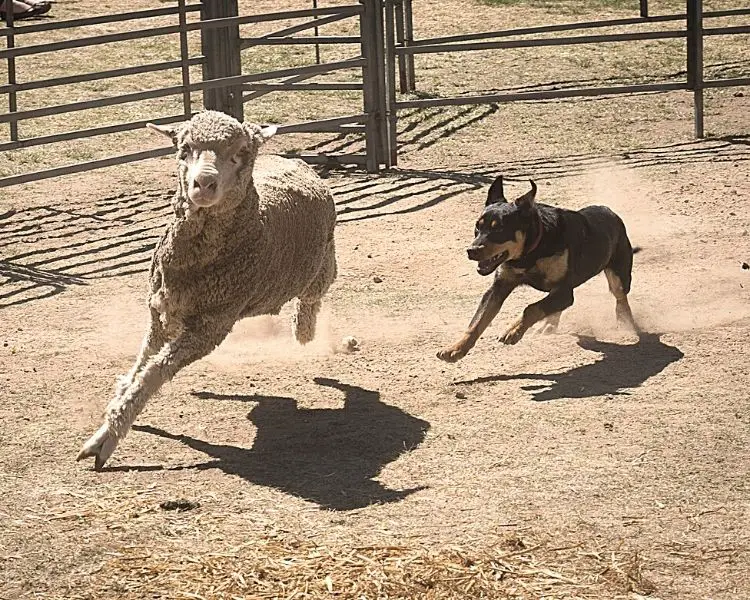
Is There A Difference Between Livestock Guardian Dogs And Herding/Working Dogs?
Yes! The behavior of livestock guardian dogs is vastly different from herding dogs. Guardian dogs usually don't herd their animals but act independently of humans and stay close to livestock to repel predators. Both breeding and proper rearing are essential factors in creating a successful guardian dog.
On the other hand, the herding/working dog has been bred to assist the shepherd, rancher, and dairy farmer in helping with day-to-day moving and controlling livestock.
We have listed the best breeds available in the U.S in both the Livestock Guardian Dog and the Herding/Working dog categories below.
How Do I Work Out Which Livestock Guard Dog Or Working Dog Is Best For Me?
It all depends on the purpose of your dog. A Great Pyrenees will be able to help you if your problem with predators is small animals such as foxes. An Anatolian Shepherd is a better option if you live in areas where wolves are a problem.
These dogs are not meant to be companion animals, which should be considered when choosing the right breed for your situation.

Dog Herding Cattle
As far as herding/working dogs are concerned, this group is known for its intelligence, energy, and affection, so it's not surprising that these dogs are some of the most beloved on the planet. These dogs were bred over centuries to herd livestock. This has made them highly skilled at this work, as well as loyal and dedicated to their owners.
How Many Herding Dogs Or Livestock Guard Dogs Should I Have?
The size of your farm, protection requirements, the number of your herd, and the age of your dogs will all impact the number of dogs you will need for either role.
There are many recommendations, and it is sometimes necessary to experiment with different numbers of dogs. For example, while some owners believe one dog is sufficient for 30-50 sheep, others will recommend two to three.
For livestock guardian dogs, it is best to wait until your chosen dog is fully grown and bonded with your herd before you add another dog, particularly a puppy. A mature adult can help a puppy livestock guardian dog learn the ropes. Even for experienced dog owners, it can be somewhat challenging to have more than one puppy at a time.
However, when it comes to herding or working dogs, introducing a puppy to your current pack at the age when it is looking to work is fine. Puppies are very much monkey see, monkey do, so being able to pair with an older, reliable working dog will help to teach your puppy the ropes from the beginning.
It is a good idea to start the training process with only one or two other working dogs to decrease the distraction factor for your puppy. It is, of course, always different strokes for different folks, so what works for some may not work for others. Again, it is at times about trial and error and learning as you grow.
Will Our Children Be Safe Around Our Working Dogs Or Guardian Dogs?
Regardless of their breed, all dogs should always be socialized adequately with all family members, including your children, to ensure they do not perceive anyone as a potential threat.
It is important to remember that working dogs are not always good companion pets and should not be acquired for this purpose alone. During the bonding process, your puppy needs to be able to focus on their job, which is either to work for the herds or to protect the livestock you want them bonded with.
It is a good idea if you are a first-time dog owner in this aspect to take some classes or attend some dog clinics or schools to learn how to make the socializing, bonding, and training process easier for you, your family, and your dog.
What Does A Livestock Guardian Dog Actually Do?
The livestock guardian can be trusted and trained to keep the flock or herd safe. Livestock guardian canines should not show aggression towards animals within the flock. They should also not be too protective of the goat kids, lambs, and calves they are protecting. For example, the dog should not try to protect the lamb from its mother.
The dog must be alert and aware. Barking is the first sign that there is a predator threat. The vast majority of livestock guardian dogs will not attack without first using other methods to ward off the attack.
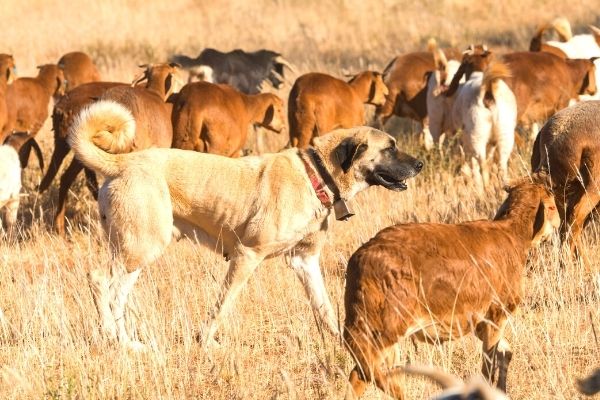
Livestock Guarding Dog
The dogs will become aggressive and louder when predators attempt to get near the herd. Generally speaking, the dog will only chase and attack a predator as a last resort. You can manage a predator problem with livestock guardian dogs without resorting to poisoning, trapping, or shooting. Although a livestock guardian dog can fight until the end, in most cases, their presence is enough to stop the predatory animal from attacking the herd.
What Does A Herding or Working Dog Actually Do?
Herding dogs use different flock management styles. It is a modified form of predatory behavior, and it is the basis of all herding behavior in dogs. Humans have created a herding dog that is efficient by selective breeding. This allows them to reduce the dog's natural tendency to prey on other animals while simultaneously maintaining the dog's hunting skills, thereby creating an effective herding dog.
Dogs can be trained to work with other animals in many ways. For example, some breeds, like the Australian Cattle Dog (for this reason, they're called heelers), can nip at other animals' heels. The Cardigan and Pembroke Welsh Corgis were used historically in similar ways in cattle drives that transported cattle from Wales to London Smithfield Meat Market. However, they are seldom used for herding.
Some breeds, such as the Border Collie, are called headers. This is because they will get to the head of the animals and stare at them. This behavior is often known as "strong eye."
Headers, also known as fetching dogs, are used for keeping livestock together. To turn the animal's movements or stop them from moving, they always go to the head or front of the animals. Both the Australian Kelpie and Australian Koolie use these methods. They also run along the backs of sheep, so they are known to head, heel and back.
What Are The Best Breeds Of Dogs For Herding And Working Livestock?
The great thing about herding dogs is that they are valued in countries that preserve herding, and they can be used to save money on equipment and labor costs. For example, Australian economic studies have shown that herding canines are worth five times more than their costs, including training and maintenance.
There is an extensive list of herding/working dogs from around the world available on Wikipedia. However, we list the top 7 utilized here in America:
Australian Cattle Dog
The Australian Cattle Dog (ACD), also known as Cattle Dog, was initially developed in Australia for droving cattle across long distances on rough terrain. The ACD is a medium-sized dog with a short coat, coming in two main colors. The dog has a mix of brown and black hair that is evenly distributed through a white coat. This gives it the appearance of a "red" or "blue."

Like other working dogs, the Australian Cattle Dog is intelligent and energetic with a strong independent streak. The Australian Cattle Dog responds well to structured training, especially if it's challenging and exciting. It was originally bred to herd animals by biting and has been known to run after children and nip at their heels as they run. It can form a strong attachment to its owner and be protective of them and their belongings.
Australian Cattle Dogs are easy to care for and brush with little effort during the shedding season. However, they can be susceptible to deafness, progressive blindness, and other health issues. Other than that, it is a sturdy breed with a life expectancy of 12-16 years.
Border Collie
Border collie descends from landrace collie, a widely found breed in the British Isles. After its likely origin at the Anglo-Scottish border, the breed was named.
The word collie is thought to be derived from the old Celtic word for "Useful." Many of today's best border collie breeds can be traced back to a dog that was once known as Old Hemp.
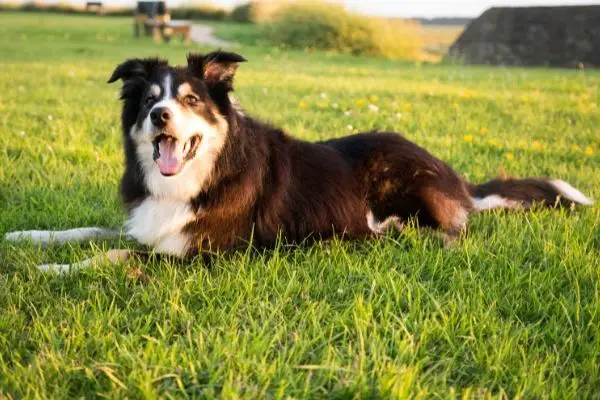
The Border Collie is of medium size. They are primarily used to herd sheep and other livestock.
The Border Collie is a bright, energetic, athletic, and intelligent dog. They are a popular competitor in sheepdog trials and various dog sports, including dog obedience, disc dog, and dog agility classes.
They are considered one the smartest of all domestic dog breeds and are still used in traditional herding livestock around the globe but are now commonly kept as pets. The border collie's natural life expectancy is between 12-15 years
Bearded Collie
It is believed that the Polish Lowland Sheepdog's ancestors were lost on the Scottish shores and were then crossed with native herding dogs; thus, the Bearded Collie's origin began.
One Scottish shepherd was so impressed by the dogs' ability to herd sheep, he traded many sheep for several dogs. The Polish sheepdogs were crossed with Scottish dogs to create the Bearded Collie.
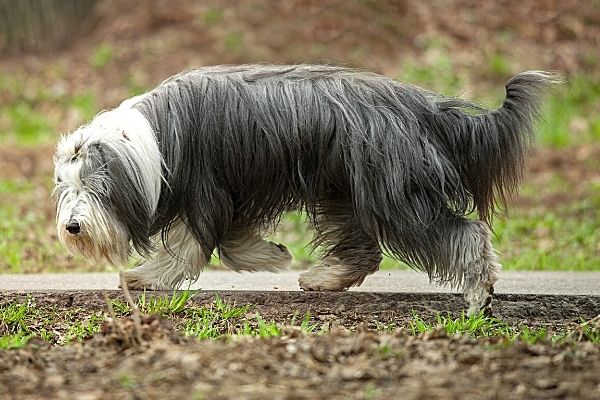
According to the American Kennel Club's annual breed ranking, the Bearded Collie ranks 117 among 175 breeds in America. They can be independent and travel from one place to another, but not necessarily in the desired way. The most common problem for new Beardie owners is their intelligence. They can easily get bored if the training gets monotonous.
Bearded Collie can be used to herd sheep and cattle. Their instinct is of a working dog as they were bred to be reliable and hardy and can withstand the most difficult sheep and harsh conditions. In the past few decades, the working Bearded Collie went through a phase of being less common but is now a popular choice for those looking for an intelligent and independent sheepdog.
The median life expectancy of purebred bearded Collie is between 10 and 13 years.
Australian Kelpie
The Australian Kelpie, or simply Kelpie, is an Australian sheepdog that can roundup and drove sheep with very little to no guidance. The Kelpie is a medium-sized dog that comes in many colors.
The Kelpie is exported worldwide and is used to herd livestock, including sheep, cattle, and goats. A Working Kelpie is a cost-effective and efficient worker that can help dairy farmers save money when they roundup livestock.

Good working Kelpies will keep livestock from leaving the farmer's range. This instinct is vital when working in a large and isolated grazing land. A good Kelpie will quietly move ahead of its owner to block the livestock (usually cattle) until the owner arrives.
They can drive livestock over long distances in harsh climates as the natural instincts of this breed to manage livestock are well-developed. They can work with sheep, cattle, and goats, as well as poultry and other domestic livestock.
The Kelpies are shown in livestock working trials and are often put on a show in yards, arenas, or large open fields where they work sheep, cattle, ducks, and goats. They tend to live to around 10–12 years.
Australian Shepherd
The Australian Shepherd is a herding breed from the United States. It was developed in California in 1921. This breed is believed to have been derived from several herding breeds, including collies that were imported alongside sheep from Australia and New Zealand.
The Australian Shepherd was originally bred as a herding dog but is now one of the most beloved companion dogs in North America.
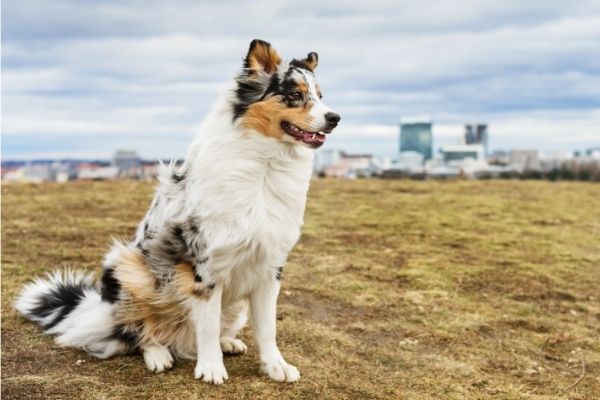
It became very popular among ranchers who appreciated its sheep-working qualities and ability to handle cattle. However, the Australian Shepherd, a working breed, was almost unknown for more than a century outside the livestock industry.
Jay Lister, a rodeo performer, popularized the breed at rodeos in the west with his Australian Shepherds performing all kinds of tricks. As a result, the Australian Shepherd Club of America was formed to promote the breed, and in 1979, the United Kennel Club recognized the breed.
The Australian Shepherd is a breed that has been increasingly seen in conformation shows since the late 20th century. In 2019, the American Kennel Club ranked it the 15th most popular dog breed in America. The median lifespans for breeds similar in size to Australian Shepherds are mostly between 11 and 13 years.
Pembroke Welsh Corgi
Pembrokeshire is where the Pembroke Welsh Corgi originated and is a breed of cattle herding dogs. Pembroke Welsh Corgis are descendants of the Spitz family.
Pembrokes are good with children and pets and will always seek attention from others. To avoid aggression or anti-social behavior, it is important to socialize the breed with children, adults, and other animals as soon as possible.
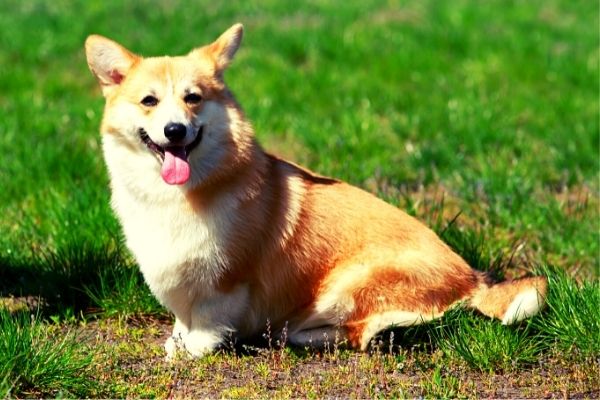
They are driven by their prey instinct and herding nature. It is best to confine them to fenced areas.
Pembroke Welsh Corgis can compete in obedience, showmanship and flyball events, and dog agility trials. Pembrokes live an average of 12-15 years.
Scotch Collie
The Scotch Collie descended from a specific herding dog breed. The Scottish breed was an aggressive, large-bodied, and strong dog bred to herd highland flocks of sheep. The Welsh variety was smaller and friendlier than the Scottish Collie, was domesticated, and could also be used to herd goats.
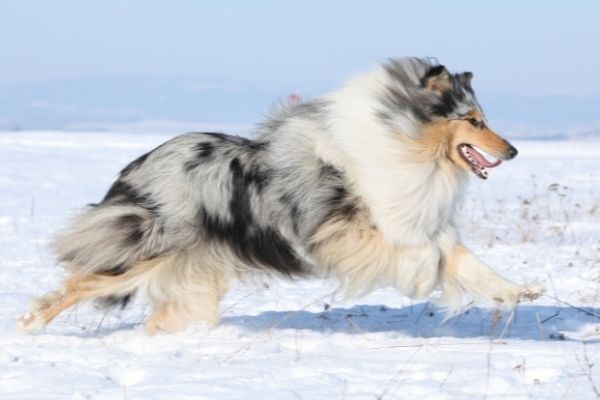
Scotch Collies can be both keen herders and flexible family members. They are great for helping out suburban owners who keep a few ducks, sheep, or goats. Participation in herding preserves Collie's unique heritage and opens up new possibilities for the owner and the dog.
They include adaptability, loyalty to the owner, training ability, flexibility, soundness in body and character, agility, and grace. These qualities are essential for making a great companion dog.
This particular Collie has a life expectancy of between 11 and 14 years.
What Are The Best Dog Breeds For Guarding Sheep And Goats?
Sheep and goats guarding preferences are similar when it comes to selecting a guard dog. Lets take a look at the dog breeds that are popular among folks for guarding sheep and goats.
- Great Pyrenees
- Akbash
- Anatolian Shepherd
- Komondor
- Kuvasz
- Maremma
Great Pyrenees
Great Pyrenees is one of the most well-known livestock guard dogs. The American Kennel Club (AKC) states that although their popularity has declined over the years, they are still popular companion dogs and great dogs for small dairy farms. They are also one of the most sought-after guard dogs breeds.
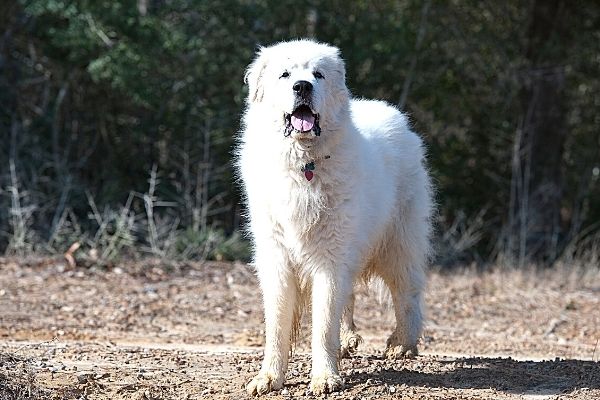
They are beautiful, and many people buy them as companion dogs.
Coyotes and feral dogs are the main targets of the Great Pyrenees' aggression. Despite their size (males can weigh in at over 50 kilos and are about 70 cm tall), they are not strong enough to deal with wolves or bears.
Although the Great Pyrenees are generally healthy, according to breeders and fans, they can develop hip dysplasia and bloat as any large breed. Some dogs may also be prone to patellar and trick knees. However, great Pyrenees can live up to 10 or 11 years if they don't suffer from health issues. This is a long life span for such large dogs.
Akbash
These white Turkish dogs, which are mostly livestock guard dogs, are not kept as pets. These dogs are larger than the Great Pyrenees, with males weighing over 60 kg and measuring 85 cm.
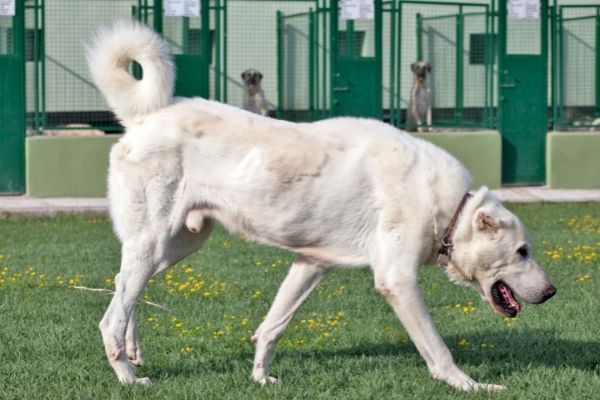
Akbash usually have dark eyes and noses. In addition, their tails and legs are generally longer. They are often working dogs and not companion animals.
Akbash fans love that the dog is quiet and low-energy. The dog can be athletic when needed but isn't aggressive and can think for itself.
Like all livestock guard dogs, Akbash are tough. Rarely do they suffer from serious dog health problems, but usually, they don't have many health issues.
Akbash live a normal life for up to 10 or 11 years.
Anatolian Shepherd
Anatolian Shepherd was first developed in Anatolia. These strong mountain dogs were bred in Asia, where they are expected to protect sheep against wolves, bears, and jackals. In addition, they can deal with coyotes, foxes, and feral dogs.
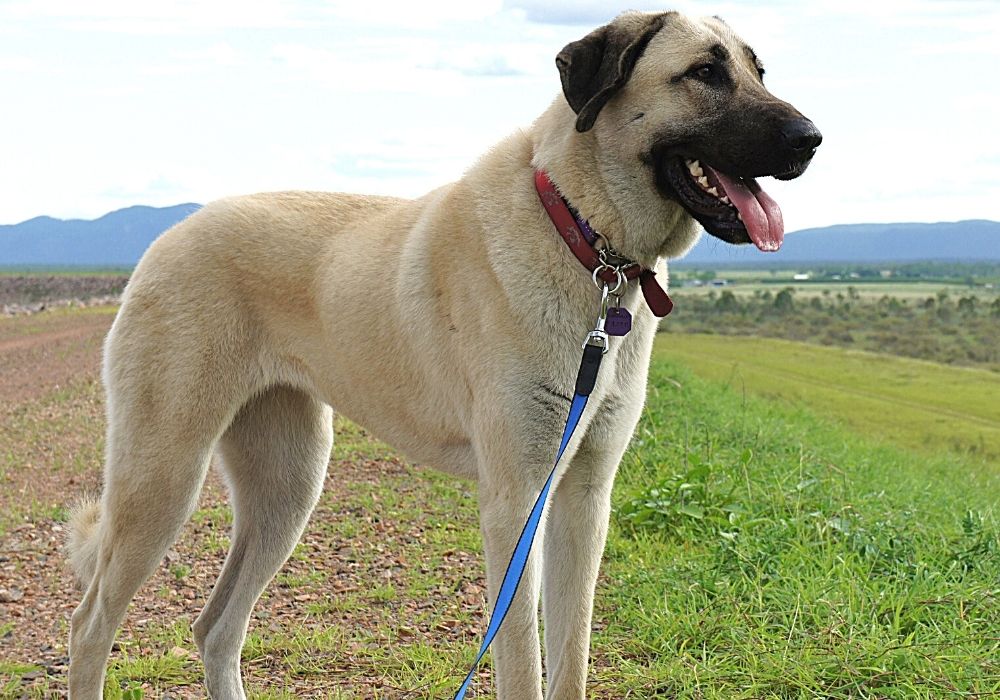
This dog is not recommended to be kept as a companion dog, just like the Akbash. Anatolian Shepherds are built for work and will often wander off if left without a herd or flock. In addition, they will not be able to socialize with strangers unless they are well trained.
Although they are not known to have any frequent health problems, there have been reports of hip dysplasia (like most large dogs). They can live for about 10 to 11 years.
Komondor
When the Komondor guards his sheep, the thick coat protects him from wolves. Like most livestock guard dogs, the Komondor is white and taller (about 80 cm at the withers), heavier (50-60 kg), but lighter than some large breeds.
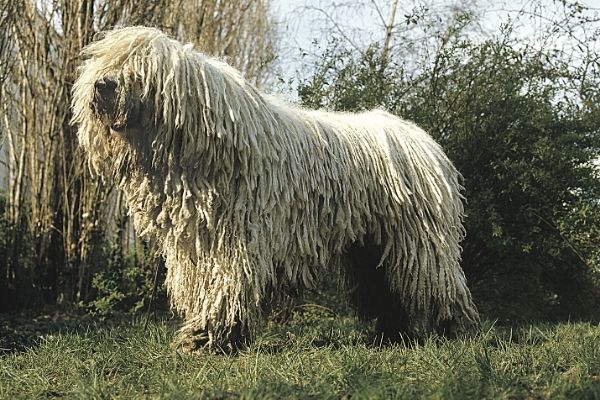
Komondors have the same temperament as livestock guard dogs but are more volatile. This could be due to a lack of training and socialization. Although they are good with children and family, they do not like to be alone. They will be more than happy if there is a job to do. It is unacceptable to confine these dogs to the suburbs or city.
Komondors are susceptible to hip dysplasia, bloat, and other health problems. In addition, dogs with thick, corded hair as Komondors are more receptive to external parasites like ticks and fleas.
Kuvasz
The Kuvasz, a white or light-colored livestock guard dog, is from Hungary. However, some believe the dog breed was even present before it arrived in Hungary.
The Kuvasz is similar to other livestock guard dogs and weigh between 50 and 75 kilograms. However, they are lighter than some livestock guard dog breeds, and their personality is the main difference.
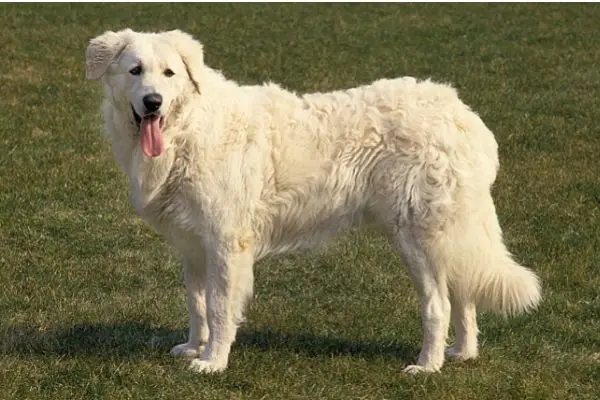
Kuvasz should be socialized early and trained in obedience if it is to be kept as a companion animal. Although they are more playful than most livestock guard dogs, they are still very independent and serious about their work. Kuvasz are known for being good with children, friendly towards other animals, and protective of their owner and family. However, they don't do tricks or follow commands off-leash.
Kuvasz can live a long life, although hip dysplasia is a common problem in large dogs. These dogs can live up to 12 years if properly fed (to avoid excess calories and rapid growth).
Maremma Sheepdog
Maremma Sheepdogs are considered "Old World European" because they share ancestry in common with other Eastern European livestock guardian breeds, such as the Pyrenean Mountain Dog or Kuvasz.

Maremma Sheepdogs love their work and would be a great fit on a dairy farm where they could look after livestock. These dogs were bred to be independent thinkers, and they are not easy to socialize or train. They get along with their human family and other dogs, but they don't like strangers. This makes them excellent watchdogs.
Some health issues can be serious with this breed, and as seen with the other breeds here, problems are more prevalent in larger dogs. However, Maremmas can live between 11-13 years if they are in good health.
What Are The Best Dog Breeds For Guarding Cattle?
While most of the guardian dog breeds could be trained to guard cattle, for the most part, in these modern times, cattle herds are left to fend for themselves. In the past, however, these few breeds were explicitly listed as being used to assist with the guarding of cattle herds in particular.
The Spanish Mastiff and Slovak Cuvac are the only livestock guardian dogs recognized by the Kennel Club. It is worth mentioning the other three breeds, however, because these are the only dogs listed as being guardian breeds specifically used for cattle.
The Spanish Mastiff
The Spanish Mastiff can be as large as 200 pounds and is a very intelligent breed. The Spanish Mastiff, as their name implies, is originally from Spain. Since medieval times, it has been used as a Livestock guarding dog to protect sheep and cattle while they were being herded from north to south Spain.

The Spanish Mastiff, extremely wary and aloof dogs, are the great guardian and can defend their herds from thieves, bears, wolves, and other predators. Although there is no longer an immediate need to herd livestock, the Spanish Mastiff is still a popular breed throughout Spain. They can be seen working as LGDs in rural areas throughout the country.
Slovak Cuvac
Slovak Cuvac is a Slovak breed of dog that was bred to be a livestock guard dog. This breed, also known as Slovensky Cuvac or Tatransky Cuvac, is closely related to Hungarian Kuvasz.
The history of this breed dates back to the 17th century. However, the Cuvac faced the possibility of becoming a forgotten breed once the modern herding methods were introduced and European wolves began to disappear as they were descendent of wolves.
Luckily, Dr. Antonin Hruza and the Brno veterinary school restored this breed and are credited with re-establishing its characteristics.
The dog has proven to be a great watchdog for cattle, turkeys, and other domestic pets and its master.

This breed is a large animal, and its white coat can reach as long as 4 inches (10cm) in length. Males can weigh between 77 and 99 pounds, while females can weigh 66 to 88 pounds. It is well-known for its sturdy structure, shaggy white hair, and a strong constitution. In addition, the dog's massive frame makes him lively, alert, watchful, and unafraid.
Slovak Cuvac thrive in a home with a lot of children, livestock, and family. The best homes for these dogs are ranches and farms. These dogs make excellent guard dogs. Also, they are loyal and gentle with their family and belongings. Slovak Cuvac is strong and resilient against all enemies, including bears and wolves.
Cão de Gado Transmontano
Cao de Gado Transmontano or Transmontano Mastiff, a Portuguese working dog, is primarily used to guard livestock. This large breed is a proven guardian dog and has a great reputation for protecting flocks of sheep from the wolves.
The Cao de Gado Transmontano could only be found in Portugal up until 1995. However, they have been exported to other parts of the globe in small numbers since 1995.
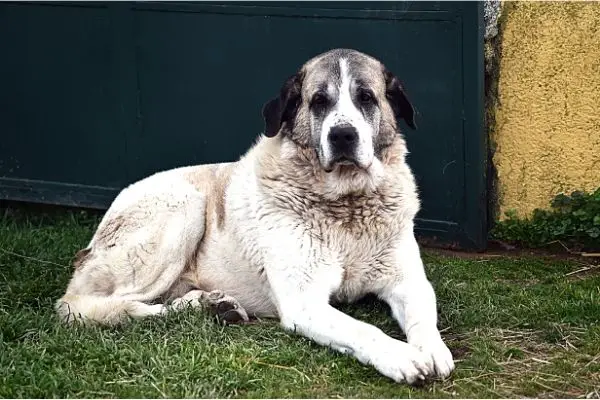
The breed is being used in Oregon, USA, as part of an effort by the Oregon Department of Fish and Wildlife to introduce large dog breeds that will help to prevent livestock from being attacked by wolves.
It is closely related to the Rafeiro do Alentejo, a southern Portuguese cattle dog that "for many centuries" followed the cattle herds in their migrations throughout the country. The two breeds became more distinct as the migrations were restricted.
Cao de Gado Transmontano is adapted to the mountainous terrain of Portugal, characterized by its steep fields of pastures and hard road access. Consequently, this breed has become accustomed to the region's conditions and to the types of cattle, sheep, and goats that have traditionally grazed in these areas.
Bakharwal Dog
Bakharwal Dog is a northern Indian breed that originated in Ladakh. It can be found in Kashmir, as well as Himachal Pradesh. The Bakharwal and Bakerwal castes bred it for centuries to protect their goats, sheep, and cattle.
Although the Bakharwal Dog could be a crossbreed of the Tibetan Mastiff and the Indian pariah, other researchers believe that the Bakharwal Dog has been around for centuries.
Bakarwal can be divided into two types: general Bakarwal or Ladakhi Bakarwal. Bakarwal is a large, strong, heavy-boned, medium-large dog and is a strong, agile mountain dog. It has a plumy tail and furry coat that give it a majestic appearance. It resembles a medium Tibetan Mastiff.
The Bakharwal Dog is most commonly found in India and in smaller numbers in Pakistan and Afghanistan.
Romanian Raven Shepherd Dog
Romanian Raven Shepherd Dogs are a natural breed that originated in the Meridional Carpathian (old Muntenia region, Wallachia), within the Dambovita and Arges counties, and around Brasov. These dogs are used to watch over properties and herd cattle.
They are also known as Corbi. Corbi in Romanian means "ravens," Their name refers to the dog's hair color, which is pure black.
The Corb is a common name in Romania for this breed. It was originally developed in the Carpathian Mountains. It has been valued as a flock watchdog and family pet for generations.
The Corb is a large breed that can reach 132 pounds and nearly 30 inches in height. However, it is known for being a "jolly and playful companion for children," intelligent and calm, and being brave when faced with predators like lynx and bears.
The Raven Shepherd is not a good choice for all people. This is due to its temperament and the fact that it requires exercise and has the instinct to guard a herd. It also has a loud, powerful bark that can be heard far away. Some sources suggest that the Raven Shepherd may tend to be independent, which can be mistaken for stubbornness.
Conclusion
Many other breeds of livestock guardian and herding dogs exist in different regions across the globe. The herding and working dogs will assist dairy farmers in moving and managing livestock.
The Guardian dogs usually don't herd animals. Instead, they generally stay close to livestock to fend off predators and guard against other potential threats.
When choosing the right dog breed for your dairy farm, you need to consider the size of your land, protection requirements, the type of livestock you have, and the herd and flock size of your animals.
